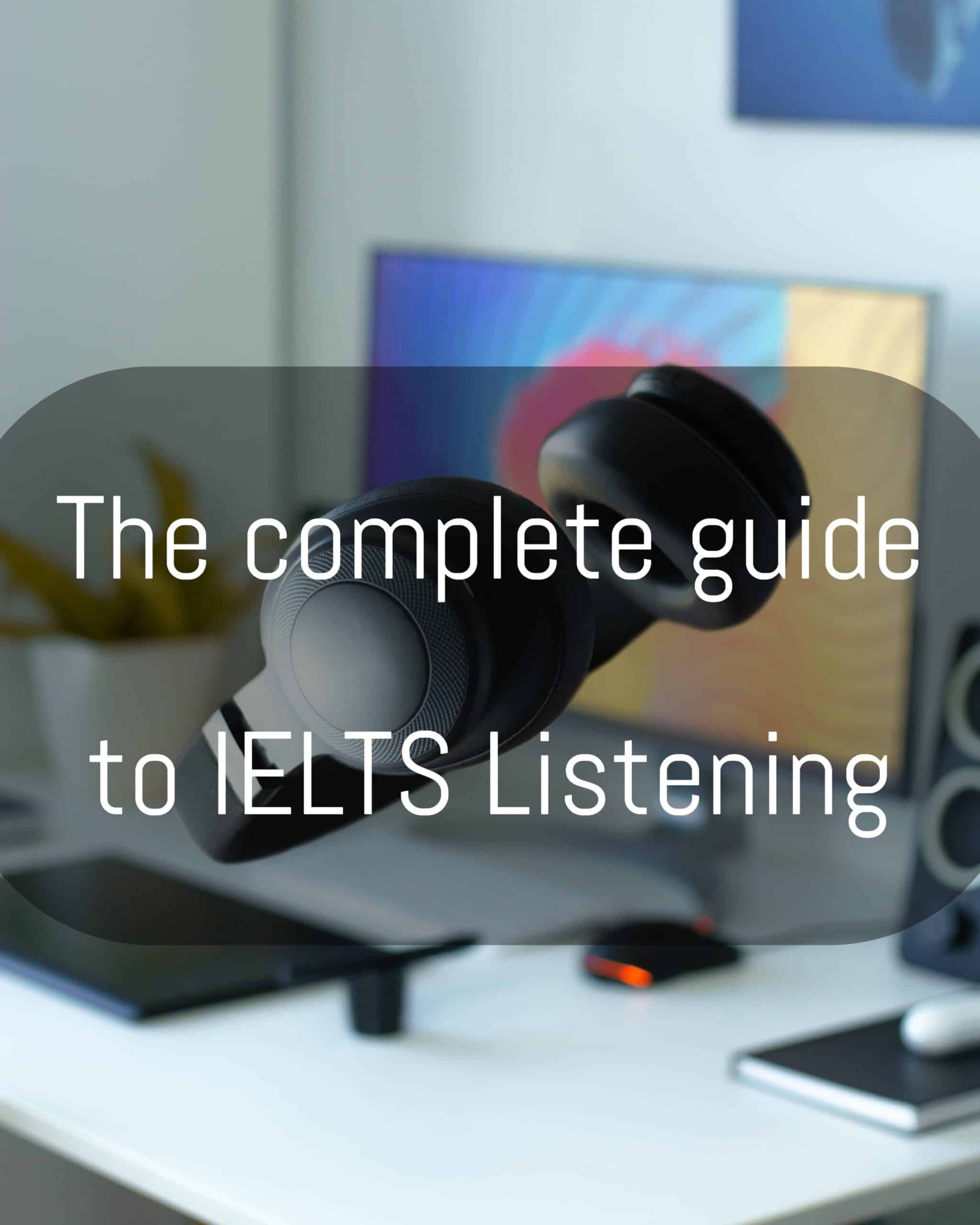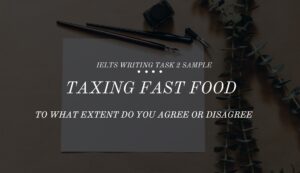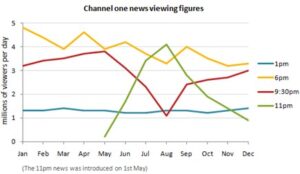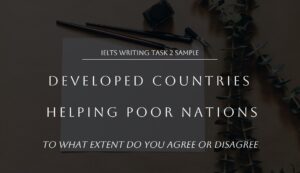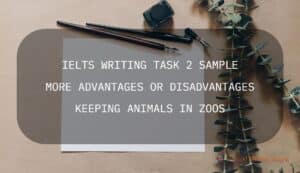The listening module in IELTS is divided into 4 parts with 10 questions each (40 questions in total). The first part is the easiest, and the fourth is the hardest. You will hear the recordings only once. The test will take around 30 minutes, and then you will have 10 more minutes in paper-based IELTS to review your answers and write them down on your separate answer sheet.
However, in computer-based test, you will only have 2 minutes at the end to review your answers. You input answers directly as you hear them.It is therefore very important that you practice a lot using appropriate techniques before you take the exam. In this guide, you will learn how to approach each question type to maximize your score.
Information about the test format and scoring
Part 1:
- two speakers
- usually about personal information in an everyday social context (e.g., booking a hotel room)
Part 2:
- one speaker
- a monologue about a general topic (e.g., a tour guide giving information about a building)
Part 3:
- two to four speakers
- a discussion in an academic context (e.g., students talking about an assignment)
Part 4:
- one speaker
- a monologue in an academic context (e.g., a university lecture)
Question: How is this module scored?
Answer: You only get points for your correct answers, and there is no penalty for incorrect ones. Therefore, you should answer all the questions and make a guess whenever you miss one. The table below can help you estimate your score:
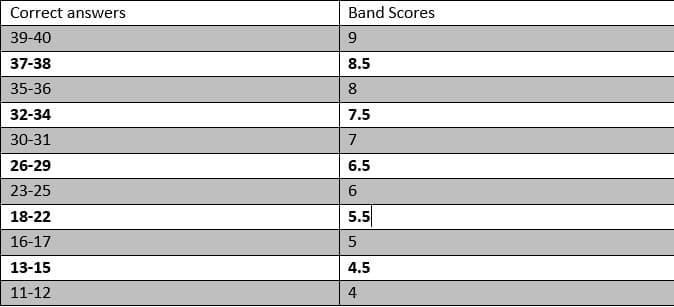
More basic information about the exam
- You will have about 20 seconds to read the questions before each part starts. Use this time to underline or highlight keywords. Usually, the speakers use synonyms or paraphrases of the keywords. You can use them to identify the answers.
- You will hear only native speaker accents. These may include British, American, Australian, and New Zealand accents.
- You will have half a minute to check your answers after each part is over. If you are sure about your answers, use this time to underline or highlight the keywords for the next part.
- Spelling is very important. The answers that are not spelled correctly will be marked wrong.
- If you hear the answer in plural form, you must write it in plural form.
- You should only write what you hear without changing it.
- Any information (names of people or places) that you are not expected to know will be spelled out. However, common names like John, Susan, Emily, Park Hotel, etc. won’t be spelled out.
- The questions follow the flow of the audio, so you will not hear the answer for question number 20 before the one for 19.
- IELTS listening exam is all about synonyms and paraphrases. It means that you won’t hear the exact words you see in the questions.
Example:
Question: The house was repaired and then modified to be used as a ………………
Speaker: The local authorities renovated the building as a museum.
- There is a word limit for each answer. If you go above the limit, your answer will be marked wrong. Take, for example, the following:
- No more than two words and/or a number means:
- one word
- two words
- one number
- one word and one number
- two words and one number
- “No more than two words” means:
- one word
- two words
Examples:
- 10 students = 1 number + 1 word
- 10% = 1 number
- $10 = 1 number
- 10 percent = 1 number + 1 word
- 10 dollars = 1 number + 1 word
- ten dollars = 2 words
- 10am: 1 number
- 10:30 = 1 number
- 10th November = 1 number + 1 word
- Hyphenated compounds also count as one word : mother-in-law = 1 word
- contractions count as one word: He’s = 1 word
Tips to help you write your answers with confidence
- Dates should be written appropriately. It means that you should choose either American or British style depending on your writing style. Here is how you do so:
Speaker: Today is the 15th of January.
If you write in the American style, follow this format:
January 15th or January 15
If you write in the British style, follow this format:
15th January or 15 January
Note: In summary, dates in American and British styles are written as explained below:
American style: Month/Day/Year
Example:
01/15/2021= January 15, 2021= Friday, January 15, 2021
British style: Day/Month/Year
15/01/2021= 15 January 2021= Friday, 15 January 2021
- An amount of money can be expressed in three ways. For example, £15.99 can be expresses like these:
- fifteen pounds ninety-nine
- fifteen pounds and ninety-nine pence
- fifteen ninety-nine
Note: Try not to write numbers as words in the listening section because it wastes your valuable time, and there is always a chance of making spelling mistakes.
- When talking about phone numbers, speakers express the digits one by one. However, you should be wary of expressions like double three (33), triple five (555), etc. Also, the number 0 can be expressed in three ways: zero, naught, and oh.
- Pay close attention to transitional words or phrases like however, although, that said, etc. They indicate a shift, which will most probably lead to the answer.
- Be wary of traps or distractors. Here are common traps in IELTS listening:
-
- Answers that change:
Example: The meeting is at 6. Oh, no, it’s at 6:30.
-
- words that look like the answer but they don’t fit the gap
Example: Jenny lives on…………..
Agent: Where do you live?
Jenny: I live in Chicago.
Agent: Do you live in a house or an apartment?
Jenny: I live on the fifth floor of a 7-story building.
Explanation: The answer is the fifth floor, not Chicago. Pay attention to the prepositions. You can’t say on Chicago. Your answer should fit the gap grammatically as well.
-
- Using similar words rather than paraphrases
Example: The reconstruction of the building finished in the year………..
Speaker: When this building was being constructed in 1973, the people were going through difficult time. The government ignored them and allocated a lot of funds to this building. As a result, there was an uprising, which led to the destruction of the new building. In 2010, however, when things were fine, funds were allocated once again to reconstruct the building and bring it to its former glory. The renovation was completed in 2014.
Explanation: The answer is 2014. We don’t need the construction year (1973), nor do we need the year in which the reconstruction began. We need the year in which it finished.
IELTS listening question types
Form completion
This type of question is a box or an official form asking for factual information like name, date of birth, phone number, age, etc. For example, a hotel receptionist is asking the customer for his or her personal information to book a room for them. The information that is already written will help you locate where the speaker is and identify the answer.
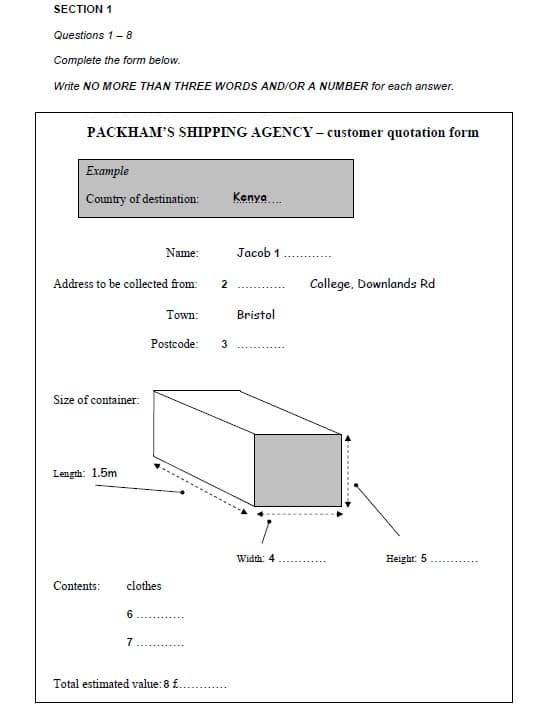
Source: Cambridge English IELTS free paper-based sample tests
Multiple choice
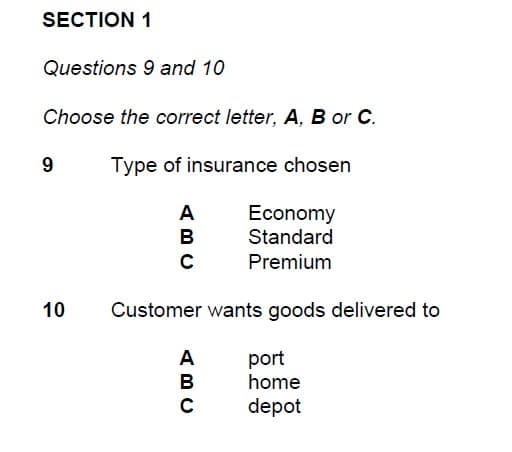
In this type of question, there is a question or an incomplete sentence with options to choose from. Sometimes the question asks you to choose more than one option, so read the question carefully before you start listening. Before you listen, read the questions first and underline/highlight the most important words or phrases that can help you locate the answers. As you listen, cross out the distractors/incorrect answers; you will finally be left with the correct one(s).
Matching
In questions like the ones below, the flow of the listening is in order of the numbers (the questions), not the letters in the box. Highlight the keywords in the numbers. When they start talking about the items, shift your focus to the box, choose the related option, and then move on to the next.
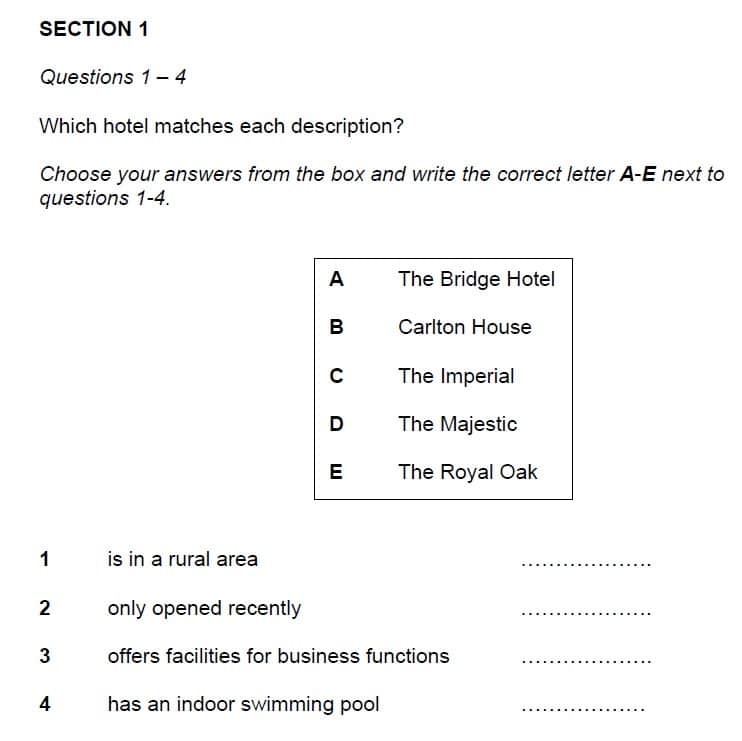
Source: Cambridge English IELTS free paper-based sample tests
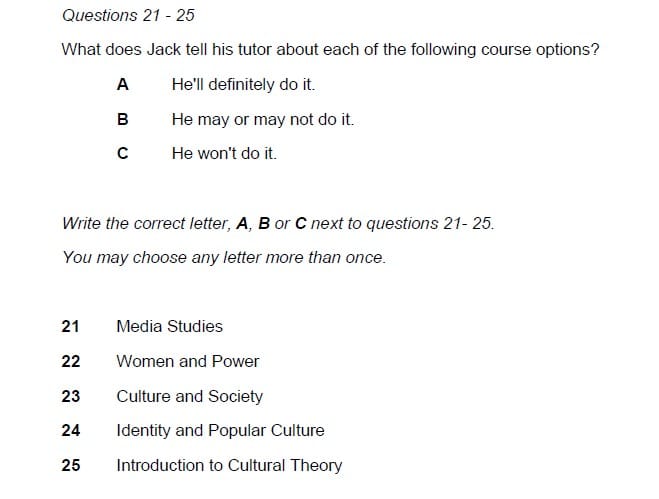
Plan, map, or diagram labeling
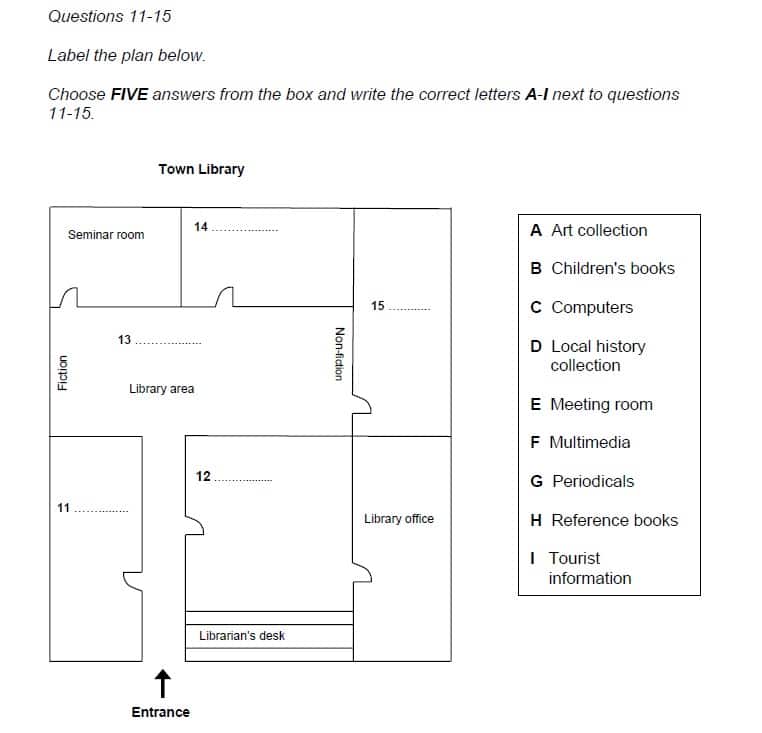
For this type of question, follow the steps below:
- Check if it is a fill-in-the-blank task with only numbered blanks on the map or matching numbers with the letters in the box.
- Study the map quickly and familiarize yourself with the names and shapes of different parts.
- Follow the speaker like you are walking in the area and look for names to fill in the blanks. Remember to keep an eye on the box of options too.
- If there are locations without names, and they are not part of the question, write their names quickly because they might come in handy later.
- When the speaker pauses for a while, it means that he or she is about to move on to the next thing.
Note completion
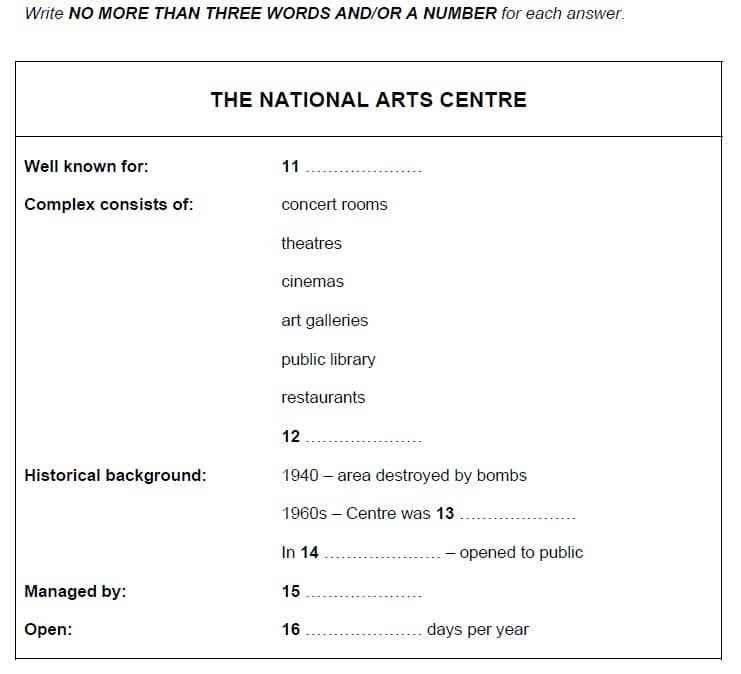
The notes are going to be organized in some format. Usually, it is a box or a bulleted list with blanks inside. Highlight keywords before you start listening, and remember not to write more words than the limit.
Table completion
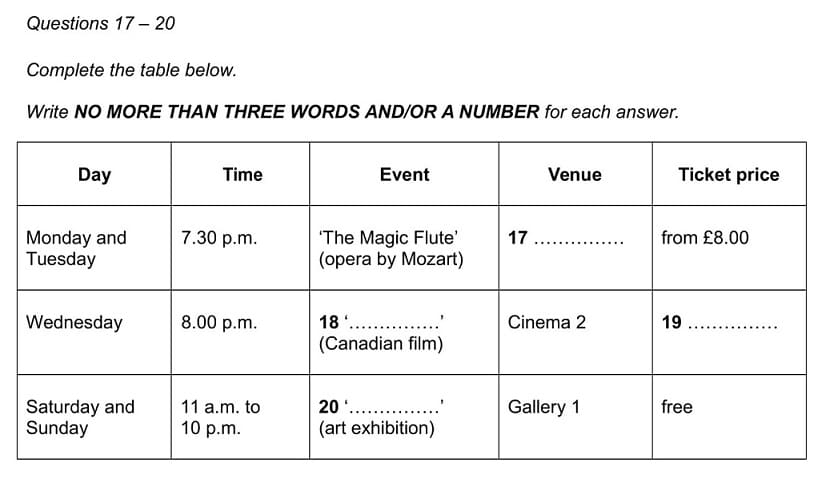
This type of question is like note completion. Focus on the column headings to know which part the speaker is talking about. Most of the time, the flow of the speech is from the first column on the left to the last column.
flowchart completion
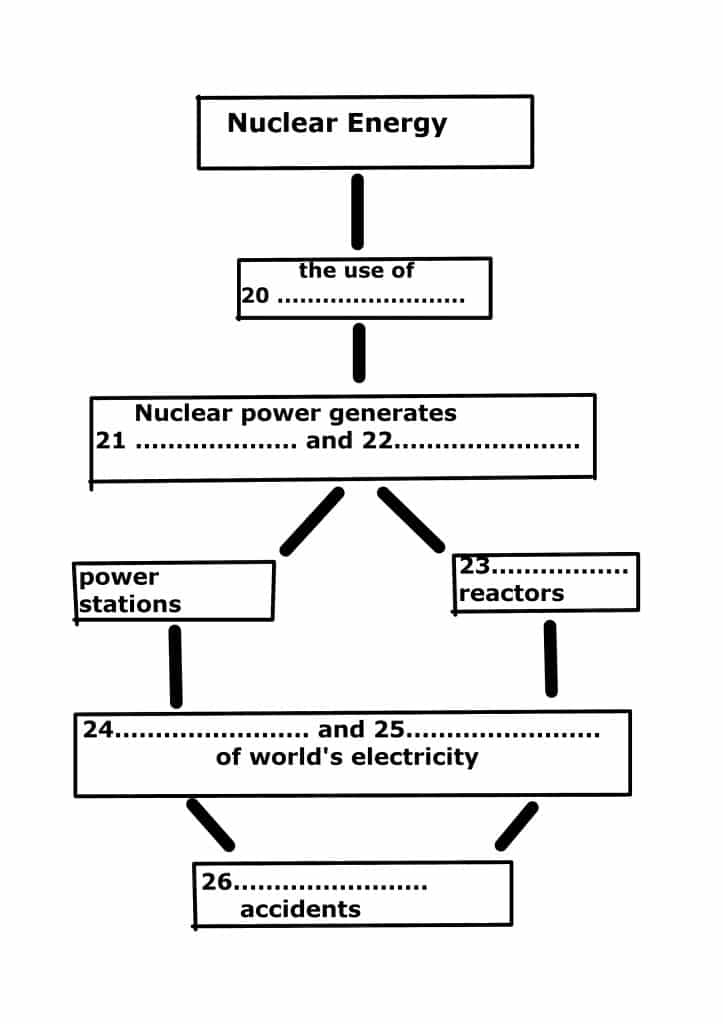
The flowcharts usually include a series of boxes or circles connected by lines or arrows with blanks inside. The flow of the speech is the same as that of the flowchart. However, you should remember that sometimes the answers that are together on the chart (like questions number 21 and 22 in the one below) may not come together in the audio. The speaker may mention one of them in a sentence and the other in the next.
Summary completion
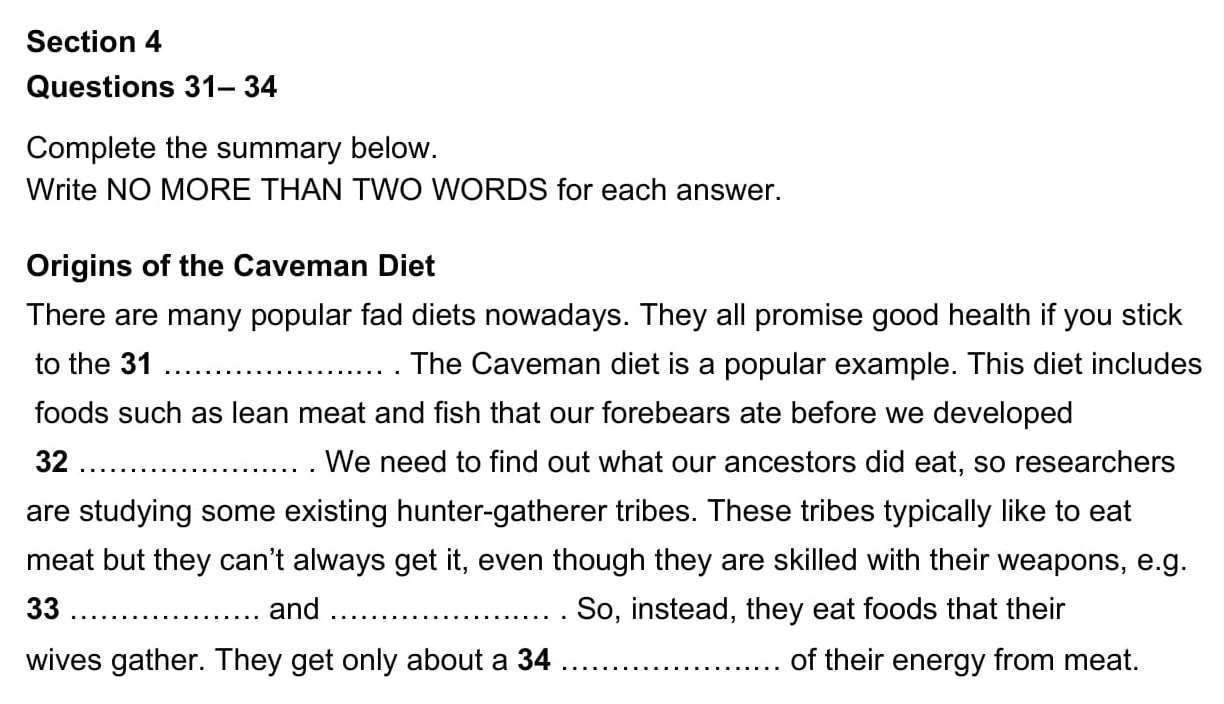
Summary completion might look the hardest for some test takers. This kind of question requires fast highlighting of keywords. The speakers are going to use synonyms or paraphrases of the keywords. For example, in the picture below, if you want to identify the answer for question number 31, you’ll need to look for paraphrases of “stick to.” The speaker might say, ” For a healthy life, you need to follow a dietary regime.
Sentence completion
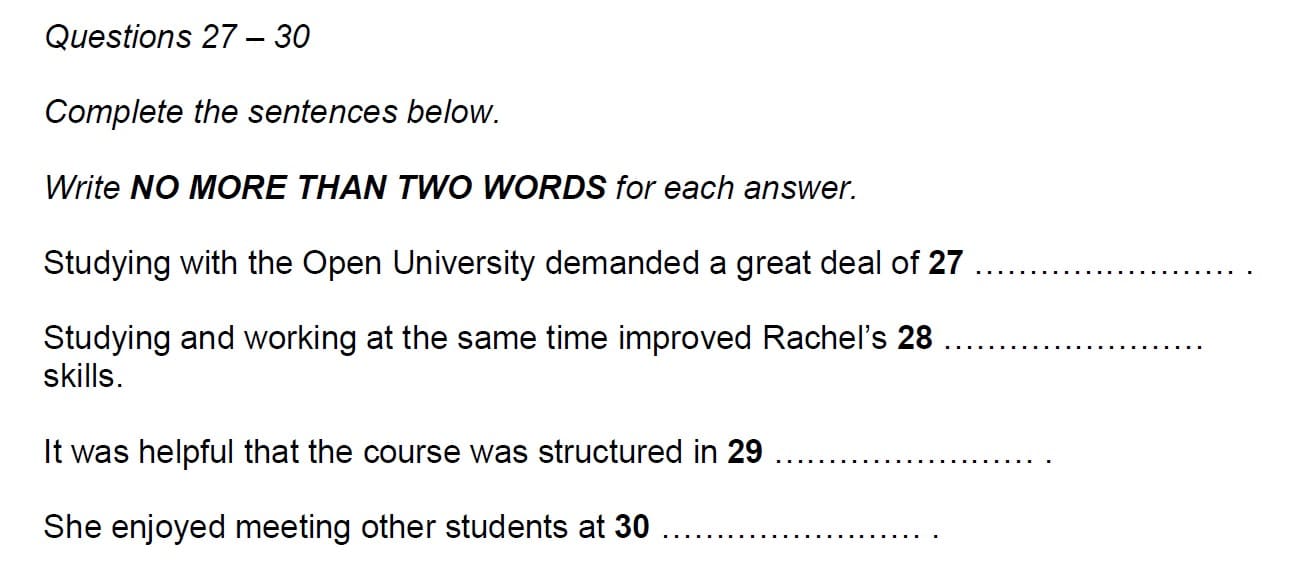
In these questions, you need to find the word(s) that fit in the blanks. Remember that you can’t make any changes to the words you hear to make it fit. For example, if you need the -ing form of the verb, but the speaker uses the past tense, you should look for another word. What you hear should be written exactly as it is said.
Short-answer questions
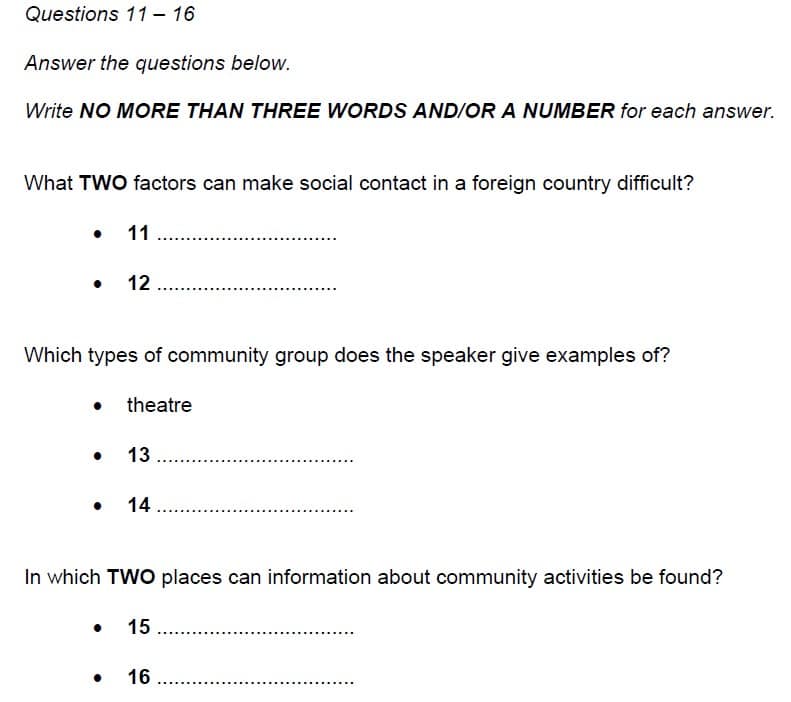
In these questions, there might be one or more gaps for a question. Each gap requires a different answer. Highlight keywords before you start listening to help you identify the answers. Only write the answers because there will be a word limit.
Articles to read and improve your language skills
Follow us on YouTube for more tips and resources.

